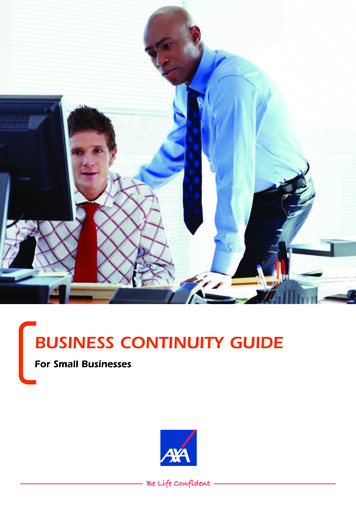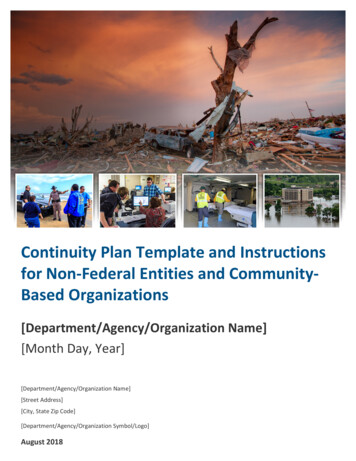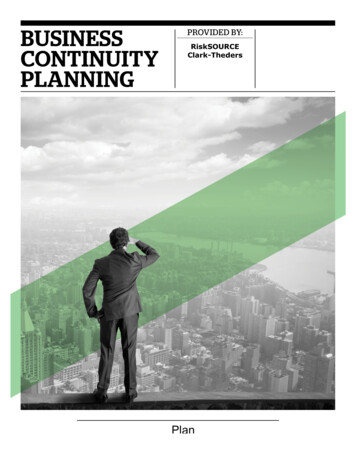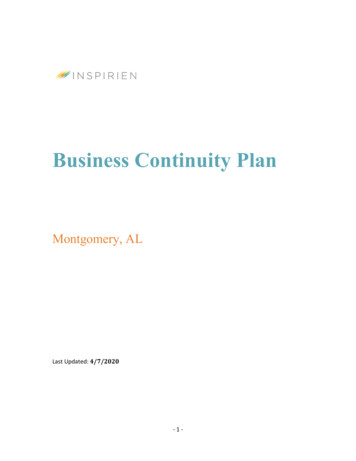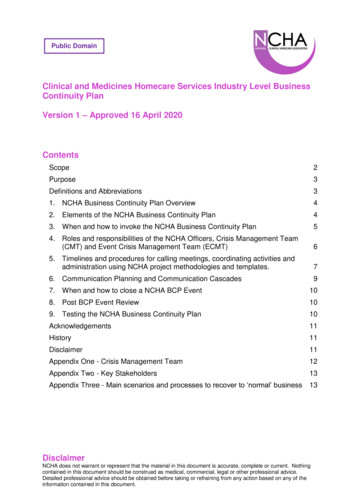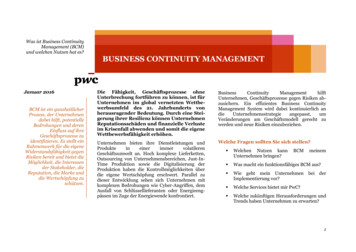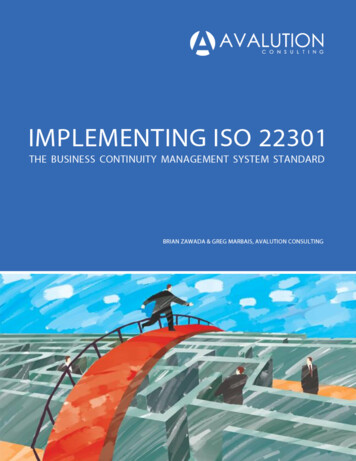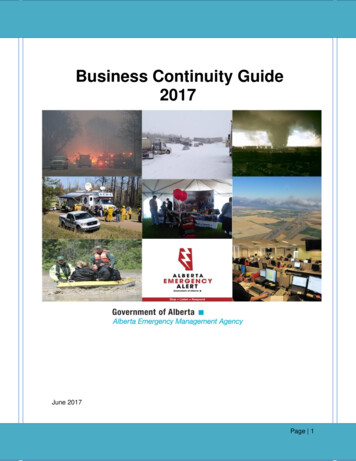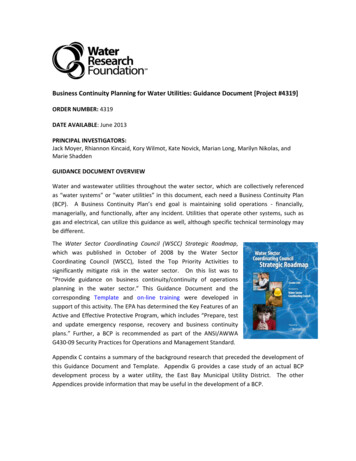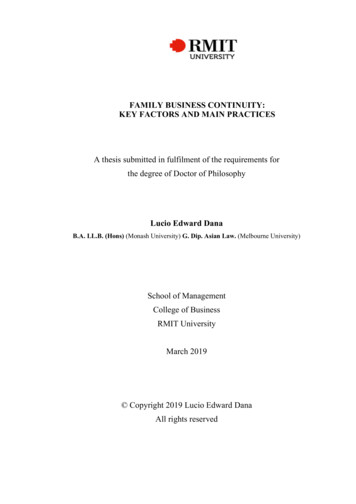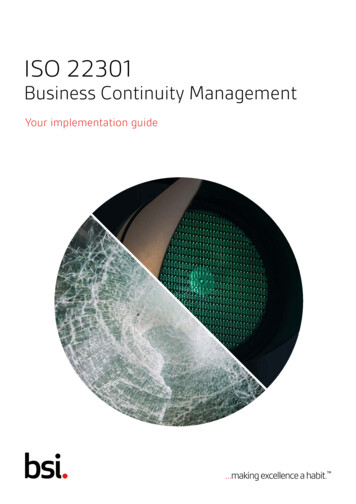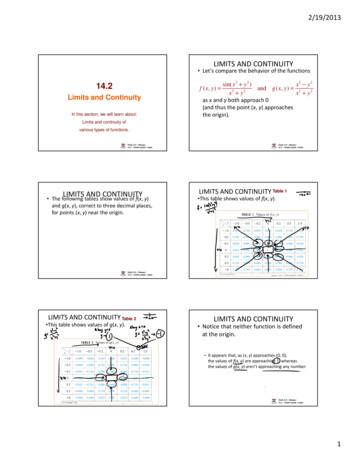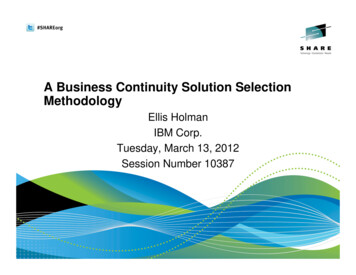
Transcription
A Business Continuity Solution SelectionMethodologyEllis HolmanIBM Corp.Tuesday, March 13, 2012Session Number 10387
Disclaimer Copyright IBM Corporation 2010. All rights reserved.U.S. Government Users Restricted Rights - Use, duplication or disclosure restricted by GSA ADP ScheduleContract with IBM Corp.THE INFORMATION CONTAINED IN THIS PRESENTATION IS PROVIDED FOR INFORMATIONAL PURPOSESONLY. WHILE EFFORTS WERE MADE TO VERIFY THE COMPLETENESS AND ACCURACY OF THEINFORMATION CONTAINED IN THIS PRESENTATION, IT IS PROVIDED “AS IS” WITHOUT WARRANTY OFANY KIND, EXPRESS OR IMPLIED. IN ADDITION, THIS INFORMATION IS BASED ON IBM’S CURRENTPRODUCT PLANS AND STRATEGY, WHICH ARE SUBJECT TO CHANGE BY IBM WITHOUT NOTICE. IBMSHALL NOT BE RESPONSIBLE FOR ANY DAMAGES ARISING OUT OF THE USE OF, OR OTHERWISERELATED TO, THIS PRESENTATION OR ANY OTHER DOCUMENTATION. NOTHING CONTAINED IN THISPRESENTATION IS INTENDED TO, NOR SHALL HAVE THE EFFECT OF, CREATING ANY WARRANTIES ORREPRESENTATIONS FROM IBM (OR ITS SUPPLIERS OR LICENSORS), OR ALTERING THE TERMS ANDCONDITIONS OF ANY AGREEMENT OR LICENSE GOVERNING THE USE OF IBM PRODUCTS AND/ORSOFTWARE.IBM, the IBM logo, ibm.com, z/OS, IMS, DB2, WebSphere, WMQ, Rational, RAD, RADz, and zLINUX are trademarks orregistered trademarks of International Business Machines Corporation in the United States, other countries, or both. If theseand other IBM trademarked terms are marked on their first occurrence in this information with a trademark symbol ( or ),these symbols indicate U.S. registered or common law trademarks owned by IBM at the time this information was published.Such trademarks may also be registered or common law trademarks in other countries. A current list of IBM trademarks isavailable on the Web at “Copyright and trademark information” at www.ibm.com/legal/copytrade.shtmlOther company, product, or service names may be trademarks or service marks of others.2
Disruptions affect more than the bottom line September 9, 2008London Stock ExchangeParalyzed by GlitchAugust 4, 2010Singapore Censures DBS Bank ForSystem Outage On July, 5 2010September 6, 2010Virginia Grapples with IT Outage. . . with enormous impact on the business Downtime costs can equal up to 16 percent of revenue 14 hours of downtime severely damaging for 32 percent oforganizations, 2Data is growing at explosive rates – growing from 161EB in2007 to 988EB in 20103Some industries fine for downtime and inability to meetregulatory complianceDowntime ranges from 300–1,200 hours per year, depending onindustry11 Infonetics Research, The Costs of Enterprise Downtime: North American Vertical Markets 2005, Rob Dearbornand others, January 2005.2 Continuity Central, “Business Continuity Unwrapped,” 2006, http://www.continuitycentral.com/feature0358.htm3 The Expanding Digital Universe: A Forecast of Worldwide Information Growth Through 2010, IDC white paper #206171, March 2007
How the disaster recover tiers aredefined Six categories of D/R solutions defined by SHARE 92 are not just acategorization as such, but are also a recognition of a trend fromrather loose to very tight D/R requirements. Not so long ago that most installations thought they were well coveredwith a PTAM (Pickup Truck Access Method) based solution. Now that data storage requirements are no longer measured inMegabytes but in Terabytes, it becomes obvious that the logistics andreliability of a PTAM solution become unmanageable Associated data loss is unacceptable and that a recovery processmeasured in days has an overwhelming financial impact due to lostbusiness, loss of company credibility and loss of shareholder value In 1992, the SHARE user group in the United States, in combinationwith IBM, defined a set of Disaster Recovery tier levels. This was done to address the need to properly describe and quantifyvarious different methodologies for successful mission-criticalcomputer systems' Disaster Recovery implementations.
Many solutions exist in the marketplace toaddress IT Business Continuity How can we select the optimum combination of solutions? How do we organize valid business continuitytechnologies? How do we manage these valid business continuitytechnologies? In the following slides we will look at Solution SelectionMethodology that can help with this issue
Business Continuity solutions are viewed asindividual product technologies andcomponents
A Solution Selection Methodology can beapplied to sort, summarize, and organizevarious business requirements The methodology can then be applied to those businessrequirements to identify efficiently a proper A valid subset of Business Continuity technologies canthen be applied based on the methodology to address therequirements With the desired Recovery Time Objective (RTO) andusing the concepts of the Tiers of Business Continuity andSolution Segmentation to identify methodically theappropriate candidate Business Continuity solutions canbe selected from among today’s Business Continuitytechnologies
Categorize all valid Business Continuity ITtechnologies into five component domains ServersStorageSoftware and automationNetworking and physical infrastructureSkills and services that are required to implement andoperate these components
IT infrastructure that is necessary to supportthe Business Continuity solution is insertedinto one of these five components
Disaster recovery tiers definedTier 0 - No off-site data Businesses with a Tier 0 Disaster Recovery solution have no DisasterRecovery Plan. There is no saved information, no documentation, nobackup hardware, and no contingency plan. Typical recovery time:The length of recovery time in this instance is unpredictable. In fact, itmay not be possible to recover at allTier 1 - Data backup with no Hot Site Businesses that use Tier 1 Disaster Recovery solutions back up theirdata at an off-site facility. Depending on how often backups are made,they are prepared to accept several days to weeks of data loss, buttheir backups are secure off-site. However, this Tier lacks the systemson which to restore data. Pickup Truck Access Method (PTAM)Tier 2 - Data backup with a Hot Site Businesses using Tier 2 Disaster Recovery solutions make regularbackups on tape. This is combined with an off-site facility andinfrastructure (known as a hot site) in which to restore systems fromthose tapes in the event of a disaster. This tier solution will still resultin the need to recreate several hours to days worth of data, but it isless unpredictable in recovery time. Examples include: PTAM withHot Site available, IBM Tivoli Storage Manager
Disaster recovery tiers defined (cont)Tier 3 - Electronic vaulting Tier 3 solutions utilize components of Tier 2. Additionally, somemission-critical data is electronically vaulted. This electronicallyvaulted data is typically more current than that which is shipped viaPTAM. As a result there is less data recreation or loss after a disasteroccursTier 4 - Point-in-time copies Tier 4 solutions are used by businesses that require both greater datacurrency and faster recovery than users of lower tiers. Rather thanrelying largely on shipping tape, as is common in the lower tiers, Tier 4solutions begin to incorporate more disk-based solutions. Severalhours of data loss is still possible, but it is easier to make such pointin-time (PIT) copies with greater frequency than data that can bereplicated through tape-based solutionsTier 5 - Transaction integrity Tier 5 solutions are used by businesses with a requirement forconsistency of data between production and recovery data centers.There is little to no data loss in such solutions; however, the presenceof this functionality is entirely dependent on the application in use
Disaster recovery tiers defined (cont)Tier 6 - Zero or little data loss Tier 6 Disaster Recovery solutions maintain the highest levelsof data currency. They are used by businesses with little or notolerance for data loss and who need to restore data toapplications rapidly. These solutions have no dependence onthe applications to provide data consistency. Tier 7 - Highlyautomated, business-integrated solutionTier 7 Tier 7 solutions include all the major components being usedfor a Tier 6 solution with the additional integration ofautomation. This allows a Tier 7 solution to ensure consistencyof data above that of which is granted by Tier 6 solutions.Additionally, recovery of the applications is automated,allowing for restoration of systems and applications muchfaster and more reliably than would be possible throughmanual Disaster Recovery procedures
Business Continuity tiers and some of IBM’sBusiness Continuity technologies by tierThe reason there are multiple Business Continuity tiers is that as the RTO timedecreases, the optimum Business Continuity technologies for RTO must change. For anygiven RTO, there are always a particular set of optimum price or performance BusinessContinuity technologies.
Map the organization’s business processesand IT applications onto the BusinessContinuity tiersBest practices for doing this is break applications and businessprocesses into segments, according to the speed of recovery that isrequired
Three segments appear to be optimum withneither underkill or overkill Continuous Availability 24x7 application and data availability (server, storage, and networkavailability) Automated failover of total systems or site failover Very fast and transparent recovery of servers, storage, network Ultimate Disaster Recovery: Protection against site disasters, systemfailures General RTO guideline: minutes to less than 2 hours Rapid Data Recovery High availability of data and storage systems (storage resiliency) Automated or manual failover of storage systems Fast recovery of data or storage from disasters or storage systemfailures Disaster Recovery from replicated disk storage systems General RTO guideline: 2 to 8 hours Backup/Restore Backup and restore from tape or disk Disaster Recovery from tape RTO 8 hours to days
Each segment builds upon foundation ofthe preceding segment Business Continuity functionality of eachsegment is built upon the technologyfoundation of the segment that is below it. In other words, Backup/Restoretechnologies are the necessaryfoundations for more advancedtechnologies It is a matter of building upwards upon thefoundations of the technologies of theprevious segment. Best practices for Business Continuityimplementation is to create a multiplephase project in which the overall BusinessContinuity solution is built step-by-stepupon the foundation of the previoussegment’s technology layer
A blended and optimized enterpriseBusiness Continuity architecture can becreated by using segmenting concepts Categorize the business' entire set of business processesinto three segments: Low Tolerance to Outage Somewhat Tolerant to Outage Very Tolerant to Outage Keep in mind some business processes that are not bythemselves critical, they do feed the critical businessprocesses Those applications need to be included in the higher tier
Segments are constructed based onbusiness needs Within each segment, there are multiple BusinessContinuity tiers of technology Individual tiers represent the major Business Continuitytechnology choices for the band It is not necessary to use all the Business Continuity tiers It is not necessary to use all the technologies After segmenting business processes and applications intothe three bands, select one best strategic BusinessContinuity methodology for the band The contents of the tiers are the candidate technologiesfrom which the strategic methodology is chosen for thatapplication segment
To be successful, management mustunderstand and back the plan Business Continuity tiers chart and business processsegmentation for your organization is also very useful as acommunication tool Tiers and segmentation concept is simple enough thatnon-technical personnel can see the bottom line RTO endresult of technical evaluations Senior management does not need to understand thetechnology that is inside the tier or segment They can clearly see the RTO and the associated costversus RTO trade-off
Sample of IBM software and where theyfit into the tiers
Establish a generalized vision of the requirementsby invoking the the methodology early in theselection cycle of technology
Gather information with the rightquestionsStart with:1. What is/are the business processes and applications that need to berecovered?2. On what IT platform or platforms does it run?3. What is the desired RTO?4. What is the distance between the recovery sites (if there is one)?5. What is the form of connectivity or infrastructure transport that will beused to transport the data to the recovery site? How much bandwidth is that?6. What are the specific IT hardware and software configurations thatneed to be recovered?7. What is the desired level of recovery? (Planned / Unplanned /Transaction Integrity)8. What is the RPO?9. What is the amount of data that needs to be recovered?10.Who will design the solution?11.Who will implement the solution?
Use the hourglass concept to segmentthe questions
Ask questions in a specific order todetermine a solution setNote: this assumes a Risk Assessment, Business Impact Analysis, andcurrent environment assessment has been completed. The answers to thesequestions come from that work.
Use RTO and Level of Recovery toidentify candidate solutionsThe Recovery Time Objective (RTO) maps to a BusinessContinuity Tier Business Continuity Tier 7 RTO: continuous to 2 hours Business Continuity Tier 6 RTO: 1 to 6 hours Business Continuity Tier 5 RTO: 4 to 8 hours Business Continuity Tier 4 RTO: 6-12 hours Business Continuity Tier 3 RTO: 12-24 hours Business Continuity Tier 2, more than 24 hours Business Continuity Tier1 RTO: 24 hours to 48 hours
Use RTO and Level of Recovery toidentify candidate solutions (continued) Planned outage: The solution is required to only facilitate plannedoutages or data migrations Unplanned outage recovery is not necessary Unplanned outage: The solution is required, at the hardware anddata integrity level, to facilitate unplanned outage recovery. Implies that planned outage support is also available in this solution Dot perform transaction integrity recovery at the application ordatabase level Transaction integrity: The solution is required to provide unplannedoutage recovery at the application and database transaction integritylevel This level relies upon an underlying assumption that hardware levelplanned outage and unplanned outage support is also available
Solutions identified by RTO and level ofrecovery - example
Eliminate those solutions which do notsuit the RTO
Turn over the solutions to be evaluatedin detail After indentifying a preliminary set of valid candidate BusinessContinuity solutions The candidate solutions would be turned over to a skilled evaluationteam Valid identified candidate solutions also dictates what mix of skills willbe necessary on the evaluation team The evaluation team will need to further configure the candidatesolutions into more detailed configurations to complete the evaluation The team will still make the final decision as to which of the identifiedoptions (or the blend of them) is the one that should be selected. Do not expect this methodology to be a perfect decision tree. It’s intent is to provide an initial identification, in a repeatable,teachable manner, that can be performed by staff of varying skilllevels, including relatively inexperienced staff
The goal of this process is to quickly identifyproper candidate technology and solutions As simple as this methodology sounds, BusinessContinuity solutions for a given set of requirements is ofsignificant value Much less time and skill is necessary to reach thispreliminary solution identification in the evaluation cyclethan would otherwise be experienced This methodology can manage the preliminary evaluationphase more consistently and repeatedly Can be taught to others easily This methodology also supports current best BusinessContinuity practices of segmenting
Update methodology as the technologychangesThis methodology flexible.The table-driven format allows for technology changes,Only the contents of the tiers chart changeThe methodology itself need not changeBusiness Continuity technology is created or enhancedand results in an improvement of its tier of BusinessContinuity capability Add new technology to the appropriate RTO/Tier cell
QUESTIONS?Please remember your sessionevaluationYour Feedback is Important to Us32
Sources IBM System Storage Business Continuity: Part 1Planning Guide, SG24-6547 IBM System Storage Business Continuity: Part 2Solutions Guide, SG24-6548 IBM System Storage Business Continuity SolutionsOverview, SG24-6684 IBM System Storage Business Continuity SolutionSelection Methodology
automated, business-integrated solution Tier 7 Tier 7 solutions include all the major components being used for a Tier 6 solution with the additional integration of automation. This allows a Tier 7 solution to ensure consistency of data above that of which is granted by Tier 6 solutions. Additionally, recovery of the applications is automated,
